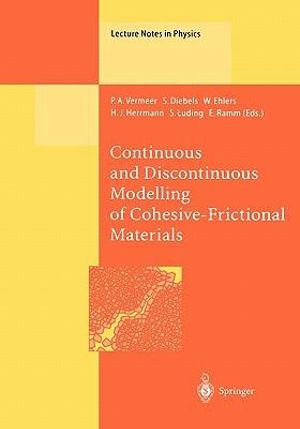| Computational models for failure in cohesive-frictional materials with stochastically distributed imperfections | p. 1 |
| Introduction | p. 1 |
| The finite element reliability method | p. 2 |
| Introduction to the reliability method | p. 2 |
| Discretisation of the material properties | p. 4 |
| Response as a function of the imperfections | p. 4 |
| Approximation of the probability of failure | p. 6 |
| Computation of the ß-points | p. 8 |
| Computation of the mechanical transformation | p. 9 |
| Computation of the equilibrium path | p. 9 |
| Computation of the gradient of the equilibrium path | p. 12 |
| Numerical simulation | p. 13 |
| Conclusions | p. 15 |
| References | p. 15 |
| Modelling of localized damage and fracture in quasibrittle materials | p. 17 |
| Representation of localized deformation | p. 17 |
| Kinematic description | p. 17 |
| Constitutive models | p. 19 |
| Numerical approximations | p. 21 |
| Combined continuous-discontinuous description | p. 22 |
| Elements with embedded localization zones | p. 23 |
| Motivation | p. 23 |
| Low-order elements | p. 25 |
| Higher-order elements | p. 26 |
| Enriched elements | p. 27 |
| Concluding remarks | p. 28 |
| References | p. 29 |
| Microplane modelling and particle modelling of cohesive-frictional materials | p. 31 |
| Motivation | p. 31 |
| Continuum-based microplane models | p. 32 |
| Microplane elasticity | p. 34 |
| Microplane elasto-plasticity | p. 36 |
| Example | p. 37 |
| Discrete particle models | p. 38 |
| Elastic particles | p. 39 |
| Elasto-plastic particles | p. 41 |
| Comparison | p. 43 |
| Short-term creep of shotcrete-thermochemoplastic material modelling and nonlinear analysis of a laboratory test and of a NATM excavation by the Finite Element Method | p. 47 |
| Introduction and motivation for the investigation of creep in shotcrete | p. 47 |
| Thermochemoplastic material model for shotcrete | p. 48 |
| State variables | p. 48 |
| Field equations | p. 49 |
| Heat conduction law | p. 49 |
| Constitutive equations | p. 49 |
| Algorithmic treatment of the incremental formulation for short-term creep | p. 52 |
| Discretization of the evolution law for short-term creep | p. 52 |
| Discretization of the incremental state equation for the stresses | p. 53 |
| Numerical example: creep test with two instants of loading | p. 54 |
| Re-analysis of a laboratory test | p. 55 |
| Modelling | p. 55 |
| Experimental determination of material properties | p. 55 |
| Results | p. 57 |
| Simulation of a tunnel driven according to the NATM | p. 58 |
| Thermo-poro-mechanics of rapid fault shearing | p. 63 |
| Introduction | p. 63 |
| Formulation | p. 64 |
| Mass balance | p. 64 |
| Energy balance | p. 65 |
| Momentum Balance | p. 66 |
| The Mathematical Model | p. 68 |
| Frictional shearing strain-rate softening | p. 72 |
| A view on the variational setting of micropolar continua | p. 75 |
| Introduction | p. 75 |
| Geometrically linear micropolar continua | p. 76 |
| Gradient type micropolar continuum | p. 77 |
| Cosserat type micropolar continuum | p. 79 |
| Mixed formulation gradient type case | p. 80 |
| Regularized mixed formulation gradient type case | p. 81 |
| Geometrically nonlinear micropolar continua | p. 82 |
| Mixed formulation gradient type case | p. 83 |
| Cosserat type micropolar continuum | p. 84 |
| Regularized formulation gradient type case | p. 85 |
| Conclusion | p. 87 |
| Macromodelling of softening in non-cohesive soils | p. 89 |
| Introduction | p. 89 |
| Approach to friction softening | p. 90 |
| Drucker-Prager model with local softening | p. 92 |
| Necessity of regularization | p. 94 |
| Nonlocal DP-model | p. 94 |
| Internal length and numerical shear band thickness | p. 96 |
| Empirical shear band thicknesses | p. 98 |
| Softening scaling on h and l | p. 100 |
| Hardening soil model | p. 102 |
| HS-model with nonlocal softening | p. 104 |
| Geometrical Nonlinearity | p. 106 |
| Conclusions | p. 107 |
| References | p. 108 |
| An experimental investigation of the relationships between grain size distribution and shear banding in sand | p. 111 |
| Introduction | p. 111 |
| Experimental device and testing procedure | p. 113 |
| Tested sands | p. 114 |
| Experimental results | p. 117 |
| Monodisperse sands | p. 119 |
| Binary mixtures | p. 123 |
| Discussion | p. 124 |
| Conclusions | p. 126 |
| References | p. 126 |
| Micromechanics of the elastic behaviour of granular materials | p. 129 |
| Introduction | p. 129 |
| Micromechanics | p. 130 |
| Branch and polygon vector | p. 130 |
| Stress, strain and work | p. 132 |
| Group averaging | p. 132 |
| Contact constitutive relation | p. 133 |
| Extremum principles | p. 133 |
| Statistical minimum potential energy theory | p. 134 |
| Discrete Element simulations | p. 134 |
| Particle size distribution | p. 135 |
| Assemblies | p. 135 |
| Discrete Element simulations | p. 135 |
| Averaging | p. 136 |
| Results from Discrete Element simulations | p. 136 |
| Geometry | p. 137 |
| Moduli | p. 138 |
| Relative displacements | p. 138 |
| Energy distribution | p. 140 |
| References | p. 141 |
| On sticky-sphere assemblies | p. 143 |
| Cohesive materials | p. 144 |
| Conclusions and recommendations | p. 147 |
| References | p. 147 |
| Cohesive granular texture | p. 149 |
| Introduction | p. 149 |
| Simple contact laws with adhesion | p. 150 |
| Examples of observed behaviors | p. 156 |
| References | p. 162 |
| Micro-mechanisms of deformation in granular materials: experiments and numerical results | p. 163 |
| Experimental results | p. 163 |
| Experimental procedure | p. 163 |
| Displacements field of rods centers | p. 164 |
| Grains rotation | p. 166 |
| Rolling without sliding | p. 166 |
| Local deformation and shear band | p. 167 |
| Numerical simulations | p. 168 |
| Numerical simulations of biaxial tests | p. 169 |
| Local mechanisms of deformation | p. 170 |
| Numerical simulation of pull-out test | p. 170 |
| Conclusion | p. 172 |
| References | p. 172 |
| Scaling properties of granular materials | p. 173 |
| Introduction | p. 173 |
| The normal force Fn | p. 174 |
| Scaling properties | p. 175 |
| Scaling large phenomena down to "lab-size" experiments | p. 177 |
| Bouncing ball | p. 181 |
| Consideration of the tangential force | p. 181 |
| Conclusion | p. 183 |
| References | p. 183 |
| Discrete and continuum modelling of granular materials | p. 185 |
| Introduction | p. 185 |
| Formulation | p. 186 |
| Continuum model | p. 186 |
| Discrete element model | p. 189 |
| Lagrangian particle method | p. 192 |
| Lagrangian particles | p. 193 |
| Numerical integration | p. 194 |
| Element matrices and particle properties | p. 195 |
| Particle splitting | p. 195 |
| Element inverse mapping | p. 197 |
| Examples | p. 198 |
| DEM model simulating a triaxial compression test | p. 198 |
| DEM model of granular flow | p. 199 |
| LPM large deformation benchmark | p. 200 |
| LPM model of discharging silo | p. 202 |
| Concluding remarks | p. 203 |
| References | p. 204 |
| Difficulties and limitation of statistical homogenization in granular materials | p. 205 |
| Definition of statistical homogenization in granular materials | p. 205 |
| Static averaging operator | p. 206 |
| Static localisation operator | p. 207 |
| General formulation | p. 207 |
| Analysis of the physical meanings of internal parameters and eij | p. 207 |
| Analysis of the capacity of different localisation operators from a numerical simulation | p. 208 |
| Kinematic averaging operator | p. 210 |
| Kinematic localisation operator | p. 213 |
| Conclusions | p. 214 |
| References | p. 214 |
| From discontinuous models towards a continuum description | p. 215 |
| Introduction | p. 215 |
| Model system and simulation | p. 216 |
| The Couette shear-cell setup | p. 216 |
| The discrete element model | p. 217 |
| From the micro-to a macro-description | p. 218 |
| Averaging strategy | p. 219 |
| Averaging formalism | p. 219 |
| Results on macroscopic scalar quantities | p. 220 |
| Volume fraction | p. 220 |
| Mass flux density | p. 220 |
| Macroscopic tensorial quantities | p. 221 |
| Fabric tensor | p. 221 |
| Stress tensor | p. 223 |
| Elastic deformation gradient | p. 223 |
| Material properties | p. 223 |
| Rotational degrees of freedom | p. 225 |
| Summary and conclusion | p. 228 |
| References | p. 229 |
| From solids to granulates-Discrete element simulations of fracture and fragmentation processes in geomaterials | p. 231 |
| Introduction | p. 231 |
| Description of the model | p. 233 |
| Granularity | p. 234 |
| Elastic behaviour of the solid | p. 235 |
| Breaking of the solid | p. 238 |
| Stress calculation | p. 239 |
| Simulation results | p. 239 |
| Quasi-static loading scenarios | p. 240 |
| Dynamic fragmentation of solids | p. 249 |
| Conclusions | p. 256 |
| References | p. 257 |
| Microscopic modelling of granular materials taking into account particle rotations | p. 259 |
| Introduction | p. 259 |
| Kinematics | p. 261 |
| Equations of motion | p. 262 |
| Contact laws | p. 264 |
| Numerical aspects | p. 268 |
| Simulation examples and results | p. 269 |
| Conclusions | p. 272 |
| References | p. 273 |
| Microstructured materials: local constitutive equation with internal lenght, theoretical and numerical studies | p. 275 |
| Introduction | p. 275 |
| A general theory for continua with microstructure | p. 276 |
| Kinematic description of a continuum with microstructure | p. 276 |
| The internal virtual work | p. 276 |
| The external virtual work | p. 276 |
| The balance equations and the boundary conditions | p. 277 |
| Microstructured continuum with kinematic constraint: Second gradient models | p. 277 |
| Equations of a second gradient model | p. 277 |
| Local elasto-plastic second gradient models | p. 278 |
| An application of local elasto-plastic second gradient model | p. 279 |
| The problem to be solved | p. 279 |
| Partial solutions | p. 280 |
| Patch conditions and full solutions | p. 282 |
| Discussion | p. 283 |
| Equations with Lagrange multipliers | p. 284 |
| Equations for the iterative procedure | p. 284 |
| Finite Element Method | p. 286 |
| Shape functions | p. 286 |
| Element stiffness matrix | p. 287 |
| Element residual terms | p. 288 |
| Global matrices | p. 289 |
| Applications: two dimensional elasto-plastic constitutive relation | p. 289 |
| Conclusions | p. 291 |
| References | p. 291 |
| Damage in a composite material under combined mechanical and hygral load | p. 293 |
| Introduction | p. 293 |
| Generation of numerical concrete | p. 294 |
| Drying process and self-desiccation | p. 295 |
| Basic elements and equations governing the processes | p. 295 |
| Material parameters | p. 296 |
| An example of simulation of drying | p. 298 |
| Endogenous and drying shrinkage | p. 299 |
| General concept | p. 299 |
| Table of Contents provided by Publisher. All Rights Reserved. |

























